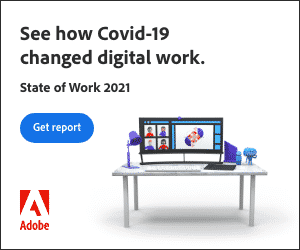 Aug 09, 2021 |
|
Good morning, Marketer, and let’s continue stitching it all together. I mean the topics and themes we cover every week. Sometimes it seems like there’s a bunch of different narratives in the space we cover, but a little reflection reveals deep connections between them. That’s something I value about Ryan Alford’s story on data confusion (see below). The deprecation of third-party cookies is obviously tied to the challenge of alternate identifiers and identity resolution. That, in turn, is connected to the value of owning your own first-party data. That in turn is related to customer relationships, LTV and community — a subject we’ll soon be diving into more deeply. All part of a pattern. But for some light relief, here’s a crossword puzzle from Ceros, the interactive content people, based on stuff marketers say (warning: “stuff” is a euphemism). I may spend my days putting words together, but crossword puzzles have always puzzled me. Good luck with it. Kim Davis
Editorial Director |
|
| | | Data | | | | | Data and confused: The increasing complexity of ad targeting | | “As the business world struggles to understand the implications of the revolving news of the third-party cookie ban, digital ad targeting is growing more complex than ever,” writes contributor Ryan Alford. He identifies the four key factors that will determine whether a business will thrive in the new environment. First, incentives. Businesses will need to focus on rich value exchanges to persuade customers to give up at least some of their data. Second, branding. Businesses should encourage customers to embrace their brand, especially across a full range of channels, including not just social media but video and podcasts. From that embrace grows the third factor — customer relationships and community, as savvy businesses move beyond transactional relationships with customers. Finally, know your customers; own your data. “As businesses struggle to adapt to the increasing complexity of data and ad targeting, there is light at the end of the tunnel,” writes Alford. “Leveraging a combination of strong brand building, data incentivization, customer relationship management, and identity resolution businesses can not only weather the storm but start building the roadmap for thriving in the growing digital landscape.” Read more here. |
|
| | | | Seizing your data destiny: Google delays third-party cookie phase-out | | Everyone agrees that third-party cookies aren’t perfect – they’re household, not individual, identifiers. Moving past cookie-based marketing makes philosophical, ethical and practical sense. However, this year-long reprieve enables companies to continue developing their own solutions and to make up lost ground and lost time. After all, personalization, measurement, and general customer experience (CX) are getting harder to execute effectively. The pandemic accelerated people’s desire for meaningful, relevant and personal experiences – without sacrificing privacy and protection. Google is simply giving a temporary stay of execution, not a pardon. Read More » |
|
| | | Transformation | | | | | Tackling CTV brand safety | | Ad measurement and authentication platform DoubleVerify has introduced new enhancements to its CTV brand safety offering, reflecting the growth of CTV and the hurdles marketers face when adding the channel to their mix. As the CTV landscape continues to mature, some of the same obstacles to brand-safe and brand-suitable ad placement traditionally associated with web advertising have wormed their way in, according to John Ross, DoubleVerify’s Director of Product Strategy. Brand risks on CTV. Linear TV is traditionally more mainstream and brand-safe than the anything-goes digital space. When linear programming is being viewed through connected devices, advertising on it assumes some of the same risks as advertising on the open internet. For instance, consumers can download streaming apps for controversial “news” shows and pornography using the CTV platform. There’s a risk that if a brand is advertising through the CTV platform, their ads could wind up in one of these environments, Ross explained. Some viewers are also using their smart TVs and CTV platforms more like desktops and mobile devices for casual video sharing, Ross said. So, in some scenarios, a user could share a viral video that they discovered within the CTV platform, and post it in a widget in the comments of a controversial or offensive site. And then your ad could show up in that widget, in a completely different environment than was intended. Programmatic CTV rising. When big brands step into the CTV space, many of them do so with a traditional insertion order (IO), as they would with linear TV placements. But more and more, advertisers are using programmatic exchanges for a more automated process. Ross estimates that the current split is 50/50 between traditional deals and programmatic placements, with the scales tipping toward programmatic. But even with a traditional ad contract, the publisher or distributor could be using an “extension network” in the form of an external partner or ad network outside of the publisher’s walls. “It’s a premium property that gets the IO, but then it winds up in other environments that aren’t as suitable,” said Ross. Read more here. |
|
| | | | How to get started on the AI / CX journey | | Artificial Intelligence is transforming the way businesses operate. And even more so, AI brings the promise of meaningful customer experiences to build deeper brand loyalty and long-lasting customer relationships. But how do you ensure your customer experience is personal, relevant and human when using AI and machine learning to improve CX? Join our experts for this webinar as they explore the impact of artificial intelligence on your customer. Learn more » |
|
| | | Social | | | | | Facebook bans researchers looking into the misinformation problem | | “Facebook has banned the personal accounts of academics who researched ad transparency and the spread of misinformation on the social network,” wrote James Vincent for The Verge last week. The social media platform claims the researchers violated its terms of service by not getting permission to use scrapers to gather user data. The NYU Ad Observatory researchers scraped the data to gather info on political ads, who pays for them, and how they spread. To do so, they created a plugin called Ad Observer: “Ad Observer is a tool you add to your Web browser. It copies the ads you see on Facebook and YouTube, so anyone can see them in our public database,” according to the plugin website. “We’ll never ask for information that could identify you… [The browser extension] doesn’t collect your personal information.” Facebook discloses some ad information in its Ad Library, but not all the data the plugin collects for research purposes. The researchers believe that the bans on their personal accounts are Facebook’s way of silencing them on the project. Why we care. This is another example of the convergence of all the things advertisers are dealing with right now: privacy, transparency, need for data, user confusion around it all, and tech company resistance. And, hey, can Facebook go a whole week without doing the wrong thing? |
|
| | | | 75+ FREE sessions and keynotes for senior marketers | | The MarTech agenda is live! Grab your free pass now to explore essential marketing issues like creating unified customer experiences, enhancing marketing automation, increasing inbox engagement, and more. It’s all available online live — September 14-15 — and on-demand so you can train when it fits your schedule. See the agenda » |
|
| | | Quote of the day | | | | | | | “There are currently two approaches to addressing the challenges facing marketers — walled gardens and open supply chains — and both are flawed. Closed environments are kind of like fast food — you have scale and simplicity, it’s easy for money and data to go in; but it’s empty calories, lacking metrics and insights, renting your customers as opposed to creating durable connections with them. “On the flip side, a fully open supply chain, in theory, looks to resolve the transparency and direct connect to media and consumer issue. Yet, it is fragmented without anything to tie all the disparate pieces and technologies together. We need an ‘enterprise open’ marketplace. The middle way where scale doesn’t require opacity, where transparency doesn’t take ten times more work.” Joe Zawadzki, founder and CEO, MediaMath |
|
|
|


